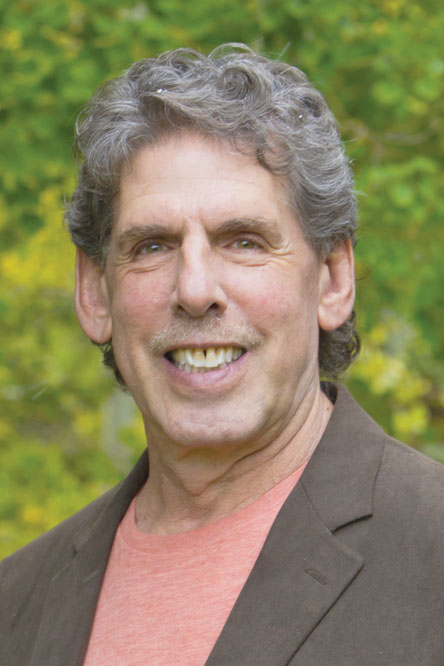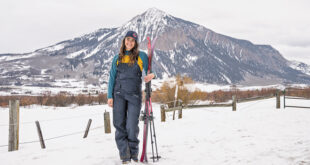by Dawne Belloise
As Robert Burns wrote, “The best laid plans of mice and men often go awry,” but for former local and town planner Myles Rademan, and the eventual population of Crested Butte, the scheme seems to have worked out well in the long-run since its inception in 1973.
Sure there are those who would argue that the directionless post-mining Crested Butte with its dirt streets, dilapidated housing and pothole celebrations was far more desirable than the rising glitz and lack of local housing that the town seems to be moving toward these days.
In fact, Rademan will be talking about this expanded topic, “Crested Butte vs. the Real World: Resort Towns’ Challenging Future,” as the keynote speaker for Crested Butte Public Policy Forum on Wednesday, July 1, at the Crested Butte Center for the Arts at 7:30 p.m., and it’s a free event.
Rademan feels returning to Crested Butte yearly is like coming home for him, although he laughs, “I didn’t exactly grow up here because I’m not sure I’ve grown up.” The septuagenarian reiterates the mantra of most who at one time or another lived or remain here. Like John Denver, Rademan says he was born in the summer of his twenty-seventh year, when he came home to a place he’d never been before. He made Crested Butte his home for 15 years from 1972.
Born and raised in Philadelphia, Rademan attended Temple University, earning a degree in history and political science. He moved to New York City to study law and urban planning at NYU, getting his dual degrees in 1969 and moving to Colorado right after that, because, he says, of a certain “pied piper” named Skip Chase, a professor of law at CU Boulder who was traveling the country in 1969 to recruit young, idealistic lawyers.
Chase “showed up in a plaid shirt with a slide show of the Rockies and really good grass. He recruited a whole bunch of us to work for Colorado Legal Services but I was finishing up my last year for a masters in urban planning,” he says of his credentials.
Then as Rademan was preparing for his move west Chase told him about a job opportunity as a community planner with the city of Denver. “I was hired on the spot and worked there from 1970 to 1972,” but Rademan grins and adds proudly, “I created so much havoc. I sued the city, which they thought was like biting the hand that feeds you, but I was suing on behalf of Denver’s west-side neighborhood, for Chicanos, because we didn’t think they were getting their fair share of the municipal services. It woke them [the city of Denver] up, and they didn’t reapply for the program that was funding me. They were very happy to see me go.”
“Most of the people I associated with were part of this group of Colorado Legal Services,” Rademan says, explaining that those lawyers worked mostly in rural areas, in little communities around the state. “Once a month we’d have a meeting and get crazy at my house in Denver. Some of them knew how to ski, which I didn’t know how to do, and a few of them had purchased a house in Crested Butte. Gerry Reese, who later became the Gunnison county judge, had purchased Cement Creek Ranch. This was happening in the early ‘70s and what happened was, my wife, who was tired of me and Denver, moved up to Crested Butte in the summer of 1972. I was still finishing up my job in Denver.”
A hippie heads to the butte
So with Rademan’s wife bolting and his Denver job ended, Reese convinced Rademan to consider Crested Butte and told him, “You should come up because there’s been this election and the hippies took over from the old timers.”
Rademan explained this was back when David Leinsdorf and Bill Crank organized a voter registration and got themselves voted in to a council newly rife with the town’s newcomers. “Gerry [Reese] said they may be able to use my help. I arrived July 4, 1972 and went to meet Mayor Bill Crank. I knocked on the door and this guy with long hair and long beard answered and said, ‘Who are you?’ I also had long hair and a long beard and I presented myself to Crank.”
Shortly thereafter, Rademan met Steve Glazer, who was writing a federal grant to get planning for the town. “Jim Kuziak, an architect who was partners with Eric Roemer, was building Penelope’s [a long-gone favorite Crested Butte restaurant] greenhouse. “I saw these two hippies up on the greenhouse roof and yelled up. I told them I was a planner. Kuziak said, ‘That’s great, I don’t know sh*t about planning.’ He had a friend engineer coming, Bruce Bumgartener.”
As Rademan was tying up loose ends in Denver, Crank called to say the town had been awarded the planning grant of $6,000 and Rademan packed up and headed back to the Butte in December 1972 to start a planning firm, named BKR (Bumgartener, Kuziak and Rademan), and to reunite with his wife.
“I was in charge of words, Kuziak was in charge of pictures, and Bumgartener was in charge of numbers,” Rademan smiles.
They laid down the foundation of what was to become the present-day town concept in Crested Butte’s first master plan.
The original plan, Rademan relates, called for basic amenities. “We have to start a fire district—it had been a volunteer fire department with a hose on wheels that they pulled by hand, and whose motto was, ‘We never lost a lot.’ We have to preserve the history and the environment. Bruce and I wrote the first grant for the historic district, which we formed.”
High on the list was upgrading the physical facilities—water, sewer, streets, and gutters, Rademan says. “We started to fix things up. We talked about diversifying the economy, working on developing festivals, providing diverse housing opportunities with alley housing, auxiliary buildings, reorganizing the government, and we wrote a municipal charter for the town, becoming a Home Rule municipality. We also recommended encouragement of citizen participation. And we actually started doing all that.”
What they recommended back in 1973 was based on the fact that the economy had failed for mining.
“A lot of people hung on but the middle-aged population of 30 and 40-year-olds had left. Ranching families stayed, some of the miners with pensions stayed, but it was a ghost town from the old photos—but there was a bunch of young hippies. We were able to revitalize the town.”
Wild and wooly
Rademan tells of a riff his neighbor had with him. “My next door neighbor was Tony Verzuh, who hated me and threatened to kill me all the time because I was a ‘socialist hippie planner.’ I had to sleep with a gun for seven years!” he laughs. “The marshal gave me that gun because Verzuh threatened me at every meeting,” Rademan smiles, shaking his head, but it was serious enough that he went target practicing a lot. “Those were the wild wooly days here.”

After they wrote the master plan, which included Cement Creek because they realized the importance of open space and that Crested Butte’s future also depended on its valley and sustainability, Crank and Rademan, with their beards and long hair, presented the plan to the Gunnison County commissioners.
“I did a slide show for it and after we did the show, Rocky Warren [one of the commissioners] looked at us and said, ‘Boys, come up here…’ so we walked up to the front dais and he’s looking down at us and says, “You know what happens when you cross a hippie planner and a hippie mayor—you f*ck things up ten years in advance.” Rademan still laughs heartily recalling that.
As with any change in town, there’s bound to be dissent and opposition. “The first thing that hit home with people was when we decided to pave Elk Avenue,” Rademan tells. “Elk Ave was a dirt street. That was the reason we all had klunkers, because there were no paved streets. We didn’t do much plowing back then, we did a minimal amount of stuff,” he says of the town’s thin coffers.
“Part of the plan was to upgrade physical facilities and we said early on that we have to get in bed with the ski area because that’s our economic engine. Our future was in tourism. There was a big cultural divide between the ski area and town—the ski area was pro-growth and town was more sustainable thinking, more environmental and not as pro-growth. We felt we should do something with Elk because it was a mess and how were we going to attract anyone to come here?”
Rademan applied for a grant to the Economic Development Administration of the federal government. He explains, “We convinced them that Elk Avenue was, in essence, our factory and we wanted to fix up Elk for the bicentennial, as a national historic district. Our economic development was our street. They bought it, and approved a $280,000 grant… that’s when the fun started… because then we included sidewalks and a green strip between the sidewalk and the street.
“The whole project turned into a battle cry that we were trying to Aspenize Crested Butte. People were opposed to change and they said it was going to ruin our town, and for them, it did. They left. A ‘Save the Baby Potholes’ group formed… they’d hold signs up at meetings,” he chuckles, but adds in seriousness, “People were angry about change. It was very controversial. In that Fourth of July parade Crank and I dressed up as the green strip, we wrapped ourselves in green toilet paper. I liked the town the way it was, but would anyone still be living here if we hadn’t fixed it up? I spent seven years fighting Amax. Some of these things don’t go away, but these are the last great places. We create magical places that are oases, bubbles, unique but they also function in an international and national economy and our country was founded on individual rights to change. Nobody has figured out how to suspend the law of economics—if something is scarce it’s valuable, if something is valuable it’s expensive and if it’s expensive only rich people can afford to buy it.”
The importance of community
In the hippie era of the beginnings of the modern town, CB was affectionately known as The People’s Republic of Crested Butte, tongue-in-cheek, but Rademan emphasizes, “Community is very important. Affordable housing is very socialistic and as Nietzsche once said, ‘Courage in the face of reality’—sometimes you have to stare reality in the face and then you act. In order to keep that idyllic setting you have to take out your checkbook—if you want certain things, you pay for it. You subsidize the things you want to keep.”
Rademan moved to Park City in 1986, citing asthma and better schooling for his son, in addition to the fact that he was not making enough to support his family as a town planner, so he took a job as a planner in another resort town.
Now, he’s a keynote speaker about resort town planning and growth, traveling nationally and internationally. He’s also served as the director of information for the 2002 Salt Lake City Olympics, and is on the board of the Park City Community Foundation. He currently serves on the Park City chamber board and the Utah Ski and Snowboard Association. Rademan still runs his own consulting company.
“I don’t look back with any regrets,” he says of his tenure in Crested Butte. “We lost a lot of battles but still, when I come back here, I don’t know a lot of resort towns that look like Crested Butte.
“It’s the community, it’s the people attracted to here. Obviously, it’s changed and will continue to change. It’s hard to stop growth. Most of our towns suffer from a cognitive dissonance disorder, when you hold mutual exclusive values and ideas simultaneously and then try to get your brain to come to grips with them. Yeah, we all love it the way it is but like the King of Hearts [a classic early 1970s movie that reflected a perceived Buttian way of life, and shown at the Princess Theatre at least twice yearly], the real world is swirling around us and intruding on our bubble—and guess what—there’s no cure. Crested Butte has done a wonderful job of taking the foundation we laid and going way beyond anything I could have imagined. Every time I come back I am thoroughly amazed and delighted.”
 The Crested Butte News Serving the Gunnison Valley since 1999
The Crested Butte News Serving the Gunnison Valley since 1999





